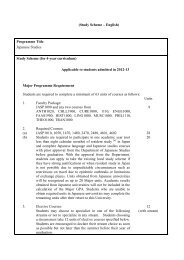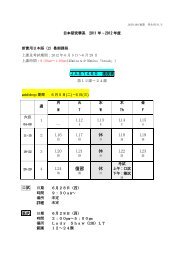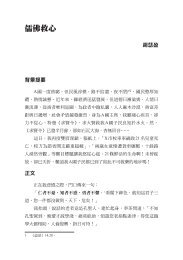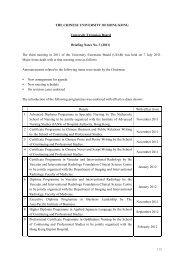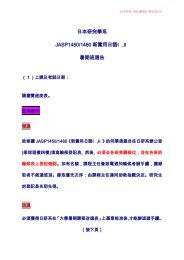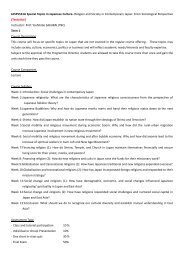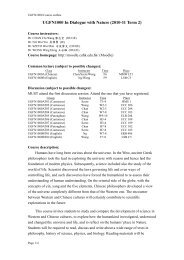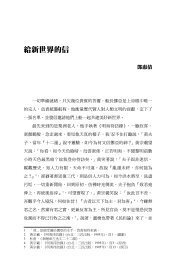ä¸è¼å ¨æ¸ - The Chinese University of Hong Kong
ä¸è¼å ¨æ¸ - The Chinese University of Hong Kong
ä¸è¼å ¨æ¸ - The Chinese University of Hong Kong
Create successful ePaper yourself
Turn your PDF publications into a flip-book with our unique Google optimized e-Paper software.
Special Topic: Assessment in <strong>University</strong> General Education Program<br />
Krathwohl et al.’s taxonomy (1964) says that affective educational<br />
outcomes can be arranged in a hierarchy, according to complexity (see<br />
Figure 1).<strong>The</strong> hierarchy begins with an ability to listen to ideas. Next, is<br />
responding in interactions with others and demonstrating values or attitudes<br />
appropriate to a particular situation. <strong>The</strong> highest levels involve displaying<br />
a commitment to principled practice on a day-to-day basis, as well as a<br />
willingness to revise one’s judgments and change one’s behavior in light <strong>of</strong><br />
new evidence (Shephard, 2008).<br />
<strong>The</strong> first level <strong>of</strong> the affective taxonomy has been labeled “receiving” and<br />
refers to a learner’s readiness to focus his or her attention on a particular issue.<br />
In order to advance in the taxonomy, a learner must be aware <strong>of</strong> or attend to<br />
something in the environment. A failure to receive information precludes the<br />
ability to move further up the affective hierarchy. Some examples that reflect<br />
this most basic level <strong>of</strong> affective learning include attending class and listening<br />
to lectures on various topics. When “receiving,” learners are discovering<br />
new concepts from their environment and are showing a willingness to learn<br />
about them.<br />
<strong>The</strong> second level, “responding,” refers to showing a small commitment<br />
to an idea by reacting to or actively responding to the information that has<br />
been “received.” Learning outcomes at this level may emphasize responses <strong>of</strong><br />
acquiescence/compliance (reads assigned materials), willingness (engages in<br />
voluntary activities), or even satisfaction in responding (shows an “interest”).<br />
At this level <strong>of</strong> affective learning, students participate in learning experiences<br />
and selectively attend to course material, as compared to alternate ideas that<br />
might capture their attention or interest. Students demonstrate “responding”<br />
when they comply with the instructor’s request to participate in class, when



